Chapter: Data Warehousing and Data Mining
Data Preprocessing
Data
Preprocessing
1 . Data Cleaning.
Data
cleaning routines attempt to fill in missing values, smooth out noise while
identifying outliers, and correct inconsistencies in the data.
(i). Missing values
1. Ignore
the tuple: This is usually done when the class label is missing (assuming the
mining task involves classification
or description). This method is not very effective, unless the tuple contains
several attributes with missing values. It is especially poor when the
percentage of missing values per attribute varies considerably.
2. Fill in
the missing value manua
lly: In
general, this approach is time-consuming and may not be feasible given a large
data set with many missing values.
3. Use a
global constant to fill in the missing value: Replace
all missing attribute values by the same
constant, such as a label like ―Unknown". If missing values are replaced
by, say, ―Unknown", then the mining program may mistakenly think that they
form an interesting concept, since they all have a value in common - that of
―Unknown". Hence, although this method is simple, it is not recommended.
4. Use the
attribute mean to fill in the missing value: For example, suppose that the
average income of All Electronics
customers is $28,000. Use this value to replace the missing value for income.
5. Use the
attribute mean for all samples belonging to the same class as the given tuple: For example, if classifying customers
according to credit risk, replace the missing value with the average income
value for customers in the same credit risk category as that of the given
tuple.
6. Use the
most probable value to fill in the missing value: This may
be determined with inference-based
tools using a Bayesian formalism or decision tree induction. For example, using
the other customer attributes in your data set, you may construct a decision
tree to predict the missing values for income.
(ii). Noisy data
Noise is
a random error or variance in a measured variable.
1. Binning methods:
Binning
methods smooth a sorted data value by consulting the ‖neighborhood", or
values around it. The sorted values are distributed into a number of 'buckets',
or bins. Because binning methods consult the neighborhood of values, they
perform local smoothing. Figure illustrates some binning techniques.
In this
example, the data for price are first sorted and partitioned into equi-depth
bins (of depth 3). In smoothing by bin means, each value in a bin is replaced
by the mean value of the bin. For example, the mean of the values 4, 8, and 15
in Bin 1 is 9. Therefore, each original value in this bin is replaced by the
value 9. Similarly, smoothing by bin medians can be employed, in which each bin
value is replaced by the bin median. In smoothing by bin boundaries, the
minimum and maximum values in a given bin are identified as the bin boundaries.
Each bin value is then replaced by the closest boundary value.
(i).Sorted
data for price (in dollars): 4, 8, 15, 21, 21, 24, 25, 28, 34 (ii).Partition
into (equi-width) bins:
Bin 1: 4, 8, 15
Bin 2: 21, 21, 24
Bin 3: 25, 28, 34
(iii).Smoothing
by bin means:
Bin 1: 9, 9, 9,
Bin 2: 22, 22, 22
Bin 3: 29, 29, 29
(iv).Smoothing
by bin boundaries:
Bin 1: 4, 4, 15
Bin 2: 21, 21, 24
Bin 3: 25, 25, 34
2. Clustering:
Outliers
may be detected by clustering, where similar values are organized into groups
or
―clusters‖.
Intuitively, values which fall outside of the set of clusters may be considered
outliers.
Figure: Outliers may be detected
by clustering analysis.
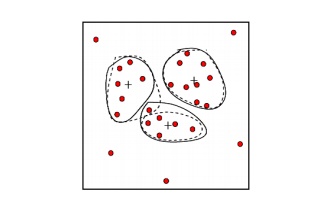
3. Combined
computer and human inspection: Outliers may be identified
through a combination of computer
and human inspection. In one application, for example, an information-theoretic
measure was used to help identify outlier patterns in a handwritten character
database for classification. The measure's value reflected the ―surprise"
content of the predicted character label with respect to the known label.
Outlier patterns may be informative or ―garbage". Patterns whose surprise
content is above a threshold are output to a list. A human can then sort
through the patterns in the list to identify the actual garbage ones
4. Regression:
Data can
be smoothed by fitting the data to a function, such as with regression.
Linear
regression involves finding the ―best" line to fit two variables, so that
one variable can be used to predict the other. Multiple linear regression is an
extension of linear regression, where more than two variables are involved and
the data are fit to a multidimensional surface.
(iii). Inconsistent data
There may
be inconsistencies in the data recorded for some transactions. Some data
inconsistencies may be corrected manually using external references. For
example, errors made at data entry may be corrected by performing a paper
trace. This may be coupled with routines designed to help correct the
inconsistent use of codes. Knowledge engineering tools may also be used to
detect the violation of known data constraints. For example, known functional
dependencies between attributes can be used to find values contradicting the
functional constraints.
2. Data
Transformation.
In data
transformation, the data are transformed or consolidated into forms appropriate
for mining. Data transformation can involve the following:
Normalization, where
the attribute data are scaled so as to fall within a small specified range,
such as -1.0 to 1.0, or 0 to 1.0.
There are
three main methods for data normalization : min-max normalization, z-score
normalization, and normalization
by decimal scaling.
(i).Min-max normalization performs
a linear transformation on the original data. Suppose that minA and maxA are the minimum and maximum values of an attribute
A. Min-max normalization maps a value v of A to v0 in the range [new minA; new
maxA] by computing

(ii).z-score normalization (or
zero-mean normalization), the values for an attribute A are normalized based on the mean and
standard deviation of A. A value v of A is normalized to v0 by computing where
mean A and stand dev A are the mean and standard deviation, respectively, of
attribute A. This method of normalization is useful when the actual minimum and
maximum of attribute A are unknown, or when there are outliers which dominate
the min-max normalization.

(iii). Normalization by decimal scaling
normalizes by moving the decimal point of values of attribute A. The number of
decimal points moved depends on the maximum absolute value of A. A value v of A
is normalized to v0by computing where j is the smallest integer such that

Smoothing, which
works to remove the noise from data? Such techniques include binning,
clustering, and regression.
(i). Binning methods:
Binning
methods smooth a sorted data value by consulting the ‖neighborhood", or
values around it. The sorted values are distributed into a number of 'buckets',
or bins. Because binning methods consult the neighborhood of values, they
perform local smoothing. Figure illustrates some binning techniques.
In this
example, the data for price are first sorted and partitioned into equi-depth
bins (of depth 3). In smoothing by bin means, each value in a bin is replaced
by the mean value of the bin. For example, the mean of the values 4, 8, and 15
in Bin 1 is 9. Therefore, each original value in this bin is replaced by the value
9. Similarly, smoothing by bin medians can be employed, in which each bin value
is replaced by the bin median. In smoothing by bin boundaries, the minimum and
maximum values in a given bin are identified as the bin boundaries. Each bin
value is then replaced by the closest boundary value.
(i).Sorted
data for price (in dollars): 4, 8, 15, 21, 21, 24, 25, 28, 34 (ii).Partition
into (equi-width) bins:
Bin 1: 4, 8, 15
Bin 2: 21, 21, 24
Bin 3: 25, 28, 34
(iii).Smoothing
by bin means:
Bin 1: 9, 9, 9,
Bin 2: 22, 22, 22
Bin 3: 29, 29, 29
(iv).Smoothing
by bin boundaries:
Bin 1: 4, 4, 15
Bin 2: 21, 21, 24
Bin 3: 25, 25, 34
(ii). Clustering:
Outliers
may be detected by clustering, where similar values are organized into groups
or
―clusters‖.
Intuitively, values which fall outside of the set of clusters may be considered
outliers.
Figure: Outliers may be detected
by clustering analysis.
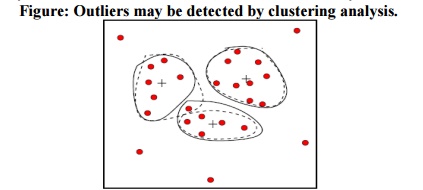
Aggregation,
where
summary or aggregation operations are applied to the data. For example, the daily sales data may be aggregated so
as to compute monthly and annual total amounts.
Generalization
of the data, where low level or 'primitive' (raw) data are
replaced by higher level concepts
through the use of concept hierarchies. For example, categorical attributes,
like street, can be generalized to higher level concepts, like city or county.
3. Data
reduction.
Data
reduction techniques can be applied to obtain a reduced representation of the
data set that is much smaller in volume, yet closely maintains the integrity of
the original data. That is, mining on the reduced data set should be more
efficient yet produce the same (or almost the same) analytical results.
Strategies
for data reduction include the following.
Data cube
aggregation, where aggregation operations are applied to the
data in the construction of a data
cube.
Dimension
reduction, where irrelevant, weakly relevant or redundant attributes or
dimensions may be detected and
removed.
Data
compression, where encoding mechanisms are used to reduce the
data set size.
Numerosity
reduction, where the data are replaced or estimated by
alternative, smaller data representations
such as parametric models (which need store only the model parameters instead
of the actual data), or nonparametric methods such as clustering, sampling, and
the use of histograms.
Discretization
and concept hierarchy generation, where raw data values for
attributes are replaced by ranges or
higher conceptual levels. Concept hierarchies allow the mining of data at
multiple levels of abstraction, and are a powerful tool for data mining.
Data Cube Aggregation
The lowest level of a data cube
the
aggregated data for an individual entity of interest
e.g., a
customer in a phone calling data warehouse.
Multiple levels of aggregation in data cubes
Further
reduce the size of data to deal with
Reference appropriate levels
Use the
smallest representation which is enough to solve the task
Queries regarding aggregated information should be answered using data
cube, when possible
Dimensionality
Reduction
Feature selection (i.e.,
attribute subset selection):
Select a
minimum set of features such that the probability distribution of different
classes given the values for those features is as close as possible to the original
distribution given the values of all features
reduce #
of patterns in the patterns, easier to understand
Heuristic methods:
Step-wise forward selection: The
procedure starts with an empty set of attributes. The best of the original attributes is determined
and added to the set. At each subsequent iteration or step, the best of the
remaining original attributes is added to the set.
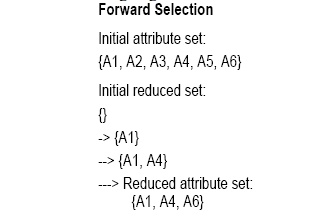
Step-wise backward elimination: The
procedure starts with the full set of attributes. At each step, it removes the worst attribute remaining in the set.
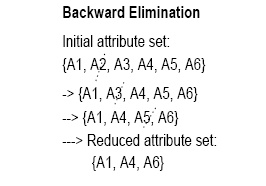
Combination
forward selection and backward elimination: The step-wise forward selection and backward elimination methods can
be combined, where at each step one selects the best attribute and removes the
Decision tree induction: Decision
tree algorithms, such as ID3 and C4.5, were originally intended for classifcation. Decision tree induction constructs a
flow-chart-like structure where each internal (non-leaf) node denotes a test on
an attribute, each branch corresponds to an outcome of the test, and each
external (leaf) node denotes a class prediction. At each node, the algorithm
chooses the ―best" attribute to partition the data into individual
classes.
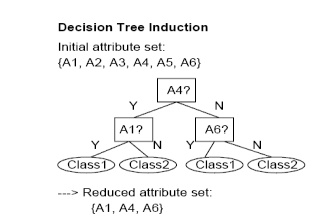
Data compression
In data
compression, data encoding or transformations are applied so as to obtain a
reduced or ‖compressed" representation of the original data. If the
original data can be reconstructed from the compressed data without any loss of
information, the data compression technique used is called lossless. If,
instead, we can reconstruct only an approximation of the original data, then the
data compression technique is called lossy. The two popular and effective
methods of lossy data compression:
wavelet transforms, and principal components analysis.
Wavelet transforms
The
discrete wavelet transform (DWT) is a linear signal processing technique that,
when applied to a data vector D, transforms it to a numerically different
vector, D0, of wavelet coefficients. The two vectors are of the same length.
The DWT
is closely related to the discrete Fourier transform (DFT), a signal processing
technique involving sines and cosines. In general, however, the DWT achieves
better lossy compression.
The
general algorithm for a discrete wavelet transform is as follows.
The length, L, of the input data vector must be an integer power of two.
This condition can be met by padding the data vector with zeros, as necessary.
Each transform involves applying two functions. The first applies some
data smoothing, such as a sum or weighted average. The second performs a
weighted difference.
The two functions are applied to pairs of the input data, resulting in
two sets of data of length L=2. In general, these respectively represent a
smoothed version of the input data, and the high-frequency content of it.
The two functions are recursively applied to the sets of data obtained
in the previous loop, until the resulting data sets obtained are of desired
length.
A selection of values from the data sets obtained in the above
iterations are designated the wavelet coefficients of the transformed data.
Principal components analysis
Principal
components analysis (PCA) searches for c k-dimensional orthogonal vectors that
can best be used to represent the data, where c << N. The original data
is thus projected onto a much smaller space, resulting in data compression. PCA
can be used as a form of dimensionality reduction. The initial data can then be
projected onto this smaller set.
The basic
procedure is as follows.
The input data are normalized, so that each
attribute falls within the same range. This step helps ensure that attributes
with large domains will not dominate attributes with smaller domains.
PCA computes N orthonormal vectors which provide a
basis for the normalized input data. These are unit vectors that each point in
a direction perpendicular to the others. These vectors are referred to as the
principal components. The input data are a linear combination of the principal
components.
The principal components are sorted in order of
decreasing ―significance" or strength. The principal components essentially
serve as a new set of axes for the data, providing important information about
variance.
since the components are sorted according to
decreasing order of ―significance", the size of the data can be reduced by
eliminating the weaker components, i.e., those with low variance. Using the
strongest principal components, it should be possible to reconstruct a good
approximation of the original data.
Numerosity reduction Regression
and log-linear models
Regression
and log-linear models can be used to approximate the given data. In linear
regression, the data are modeled to fit a straight line. For example, a random
variable, Y (called a response variable), can be modeled as a linear function
of another random variable, X (called a predictor variable), with the equation
where the variance of Y is assumed to be constant. These coefficients can be
solved for by the method of least squares, which minimizes the error between
the actual line separating the data and the estimate of the line.
Multiple regression is an
extension of linear regression allowing a response variable Y to be modeled as a linear function of a
multidimensional feature vector.
Log-linear models approximate
discrete multidimensional probability distributions. The method can be used to estimate the probability of each cell in a
base cuboid for a set of discretized attributes, based on the smaller cuboids
making up the data cube lattice
Histograms
A
histogram for an attribute A partitions the data distribution of A into
disjoint subsets, or buckets. The buckets are displayed on a horizontal axis,
while the height (and area) of a bucket typically reects the average frequency
of the values represented by the bucket.
Equi-width: In an equi-width histogram, the width
of each bucket range is constant (such as the width of $10 for the buckets in
Figure 3.8).
Equi-depth (or equi-height): In an equi-depth
histogram, the buckets are created so that, roughly, the frequency of each
bucket is constant (that is, each bucket contains roughly the same number of
contiguous data samples).
V-Optimal: If we consider all of the possible
histograms for a given number of buckets, the V-optimal histogram is the one
with the least variance. Histogram variance is a weighted sum of the original
values that each bucket represents, where bucket weight is equal to the number
of values in the bucket.
MaxDiff: In a MaxDiff histogram, we consider the difference between each pair of adjacent values. A bucket boundary is established between each pair for pairs having the Beta largest differences, where Beta-1 is user-specified.
Clustering
Clustering
techniques consider data tuples as objects. They partition the objects into
groups or clusters, so that objects within a cluster are ―similar" to one
another and ―dissimilar" to objects in other clusters. Similarity is
commonly defined in terms of how ―close" the objects are in space, based
on a distance function. The ―quality" of a cluster may be represented by
its diameter, the maximum distance between any two objects in the cluster.
Centroid distance is an alternative measure of cluster quality, and is defined
as the average distance of each cluster object from the cluster centroid.
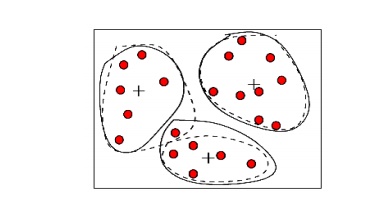
Sampling
Sampling
can be used as a data reduction technique since it allows a large data set to
be represented by a much smaller random sample (or subset) of the data. Suppose
that a large data set, D, contains N tuples. Let's have a look at some possible
samples for D.
Simple
random sample without replacement (SRSWOR) of size n: This is
created by drawing n of the N tuples
from D (n < N), where the probably of drawing any tuple in D is 1=N, i.e.,
all tuples are equally likely.
Simple
random sample with replacement (SRSWR) of size n: This is
similar to SRSWOR, except that each
time a tuple is drawn from D, it is recorded and then replaced. That is, after
a tuple is drawn, it is placed back in D so that it may be drawn again.
Cluster
sample: If the tuples in D are grouped into M mutually disjoint ―clusters",
then a SRS of m clusters can be
obtained, where m < M. A reduced data representation can be obtained by
applying, say, SRSWOR to the pages, resulting in a cluster sample of the
tuples.
Stratified sample: If D is
divided into mutually disjoint parts called ―strata", a stratified sample of D is generated by obtaining a SRS
at each stratum. This helps to ensure a representative sample, especially when
the data are skewed. For example, a stratified sample may be obtained from
customer data, where stratum is created for each customer age group.
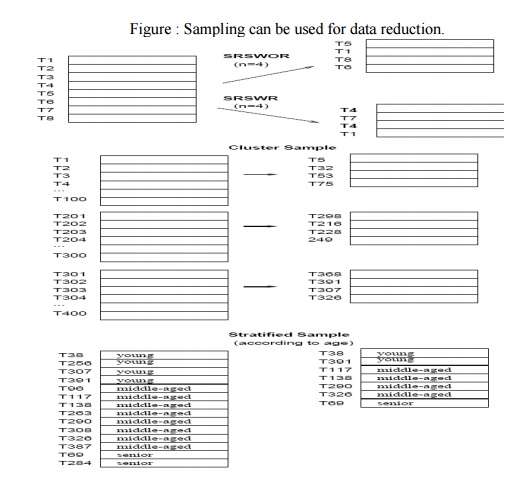
Related Topics